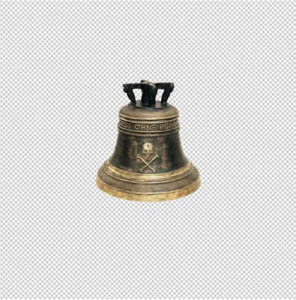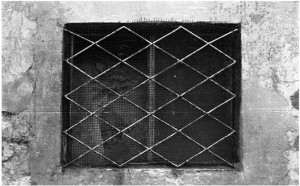Correspondence
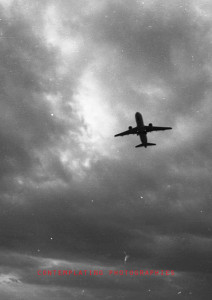 About the Immateriality of Photography or,
About the Immateriality of Photography or,
the Spirit without a Body
A text by Xandra Popescu and Adrian Knuppertz
Adrian Knuppertz
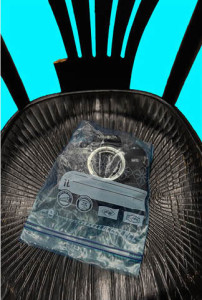 As contemporary artistic practice, we might have to stop taking analog pictures, I´m afraid. Still, as the common use of instagram remarkably demonstrates, there appears to be a nostalgia for its aesthetics, as this is the aesthetics of our childhood memories. It can create intimacy. It is the visualization of something we have seen before thus something that we know of, about what we are certain. Don’t we ask from time to time for just a little more certainty, something tangible,about some sort of shelter? Something that feels like home?
As contemporary artistic practice, we might have to stop taking analog pictures, I´m afraid. Still, as the common use of instagram remarkably demonstrates, there appears to be a nostalgia for its aesthetics, as this is the aesthetics of our childhood memories. It can create intimacy. It is the visualization of something we have seen before thus something that we know of, about what we are certain. Don’t we ask from time to time for just a little more certainty, something tangible,about some sort of shelter? Something that feels like home?
Home is a place that only exists in our memories. Said someone. Said Virilio wrote Goethe, or was it Dr. Schreber from the movie Dark City?
Some weeks ago I stumbled over some new, even more shocking, Miley Cyrus pictures, research.
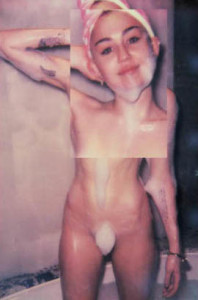 What got my attention is how these images employ analog, polaroid aesthetics to mimic some intimacy between Miley and you, they shall suggest a nasty but innocent proximity between the spectator and barely legal Miley, for your eyes only. This is nothing new, a thing used to make male researchers give in credit card information ever since the introduction of internet to the masses. Just that this time it is the 150 mio. $ brand Miley Cirus who is asking exclusively you to pass her the soap. The aesthetics of the analog and what comes along with it, its different, antique definition of to share and to exchange -you pass me the soap, I pass you this pic- are in this very context the means of persuasion. Be certain of her affection, own her like you own the negative of this very photograph, a photograph then lovers would take on their first weekend trip to another place at some Motel Inn in the vicinity of a town without name.
What got my attention is how these images employ analog, polaroid aesthetics to mimic some intimacy between Miley and you, they shall suggest a nasty but innocent proximity between the spectator and barely legal Miley, for your eyes only. This is nothing new, a thing used to make male researchers give in credit card information ever since the introduction of internet to the masses. Just that this time it is the 150 mio. $ brand Miley Cirus who is asking exclusively you to pass her the soap. The aesthetics of the analog and what comes along with it, its different, antique definition of to share and to exchange -you pass me the soap, I pass you this pic- are in this very context the means of persuasion. Be certain of her affection, own her like you own the negative of this very photograph, a photograph then lovers would take on their first weekend trip to another place at some Motel Inn in the vicinity of a town without name.
Just you and the 150 mio. $ Miley Cirus Brand.
I really need to think about photography.
 Nevertheless analogue´s tactile, nostalgic aesthetics gives us the illusion of a time when we at least believed that we do not know what is going on, (known unknowns) as it happens behind our backs in reality, whereas today we can be sure to not know what it is we do not know. (unknown unknowns). Baudrillard figured that out 25 years ago when he analyzed that everything basically becomes a satellite and dissolves, War, money exchange, technosphere and communication circulate in an inaccessible thus virtual space. transcendence of evil, transcendent, we do not know that we don´t know. With the invention of digital photography the photograph moved to the realm of virtuality, just as basically all information related disciplines melted from solid into data long time ago. its haptic, physical character, it´s objecthood and the fetish that comes along with it is due to question.
Nevertheless analogue´s tactile, nostalgic aesthetics gives us the illusion of a time when we at least believed that we do not know what is going on, (known unknowns) as it happens behind our backs in reality, whereas today we can be sure to not know what it is we do not know. (unknown unknowns). Baudrillard figured that out 25 years ago when he analyzed that everything basically becomes a satellite and dissolves, War, money exchange, technosphere and communication circulate in an inaccessible thus virtual space. transcendence of evil, transcendent, we do not know that we don´t know. With the invention of digital photography the photograph moved to the realm of virtuality, just as basically all information related disciplines melted from solid into data long time ago. its haptic, physical character, it´s objecthood and the fetish that comes along with it is due to question.
Just as Hito Steyerl points out In the Defence of the Poor Image, also the photograph, when turning from analog, physical existence into a digital, immaterial, virtual one, once online (probably just on your computer might be enough) it becomes disposable to uncontrollably be copied as there is no more primordial negative, Its once serial character that functioned to evaluate it, turns infinite, its exclusiveness emancipates to free for all, it “accelerates as it deteriorates”, it might be cropped, remixed also. These are no revelations, no big news.
But other than video something else is taking place.
The photograph loses its body it becomes “Geist ohne Körper”
The absence of the body is one central historic discourse in philosophy, the mind and body problem and the question if one can live without the other have been subject of thought big time. According to Socrates and Plato it is the mind/soul that is existential for the nature of human beings and the body´s function is -oversimplified- just that to carry it for the short period of its terrestrial existence, furthermore the connection of mind and body must feel like a bondage and therefore the body´s death shall feel like disimprisonment to mind.
Xandra Popescu
Descartes divides the entity of the ego into res cogitans, the mind/soul, the thinking matter/thing and res extensa, the body/materia. In Phaedo, Plato calls the body a prison for the mind. Descartes’s first meditation Concerning Those Things That Can Be Called Into Doubt and second meditation Concerning the Nature of the Human Mind: That It Is Better Known Than the Body which develop the dualist perspective are a build up to the third meditation Concerning God and That He Exists.
So what dualism pertains to is the existence of God but even more importantly the possibility of life after death. If mind and body can exist apart, then our soul can survive the death of our body.
But what does this mean in the case of analog versus digital photography? If we were to extrapolate the mind body binary – because of its materiality and haptic qualities analog photography would represent the body, while, on account of its immateriality, digital photography would represent the spirit.
So if photography no longer needs a material medium maybe we could proclaim it free from the cage of its body. Could we further speculate that the era of digital photography represents a life after death? Is digital photography the purgatory of representation?
Indeed analog cameras are of the domain of the past except for the precious fetishists – while video possibilities are becoming omnipresent. The death of the analogues coincides with the proliferation of moving image.
Inspired by Hito Steyerl’s theorisation of the relationship between work, occupation and art, I intend to use these tools for thought in a joint venture with the security guards of Bucharest. My plan is to create a series of moving image portraits. Along with interns and museum wards, security guards fall within the same occupational pattern – being available for whatever eventuality – just in case. Of course in 99% of the time it’s not the case – because nothing happens. But they are there waiting for something improbable and inopportune to occur.
The simple presence of security guards makes danger improbable – leaving them without a purpose. Pre-occupied and yet un-occupied. Ready to go but without a destination. So what is a security guard to do in the absence of danger?
A retired guard once told me that his job was “to make sure that nothing exciting was going on”. Prudence and inbuilt skepticism is what the job seems to require. That and of course fitness and the ability to intimidate.
But perhaps the most underestimated asset is the ability to daydream and project. Daydreaming I would argue, is an inextricable element of the “professions of waiting”. Cautiousness and prudence may seem like a good idea but it’s actually projection and idleness that one needs to stay on the job. Projection as an antidote to alienation. An endurance of injection into the spleen of waiting. Otherwise, how can one be there without being there?
So this particular is choice of subject, the security guards, is also justified by the co-incidental dis-junction of body and mind which often occurs in “professions of waiting”. Marx referred to it as al alienation but for the purpose of this project let’s just call it “an absence of spirit”.
Taking the relationship of absence and projection even further, we would like to refer to the contemporary self documentation obsession (snapshot, selfies instagram). Recently, while on the S Bahn, Adrian observed a group of young people working very hard at looking like they’re having fun. Tension was in the air. A couple of them were frustrated that they had taken the wrong connection and that made them late for a club gig they probably had no chance of getting into. But apart from that, they were clearly not having any fun at all – yet working intensely at generating that idea in retrospect. I have witnessed similar scenes myself and have often taken part in such conspiracies of “want to be” and “make believe”.
But beyond the ridicule, what interests me is the solipsistic nature of the gesture. In such cases Descartes’ “I doubt therefore, therefore I think, therefore I exist” transforms into “I am shooting, I am posting, therefore I exist”.
The way we constantly stage ourselves up for a picture,the way we strike poses and carry ourselves in front of the camera encapsulate our availability and desire to be seen. To be perceived in a certain way. A type of self projection and I would dare name it self-surveillance. Is this type of absence symptomatic for the omnipresence of digital cameras? This extreme facility of taking photos seems to be rendering us absent. We are here but already elsewhere: in a near future where someone is checking our Facebook pictures.
But back to our security guards: in their case being seen is also part of the job since their efficiency depends on their potential to intimidate.
This is what the job requires. But how about their personal projections. What is behind such masks of intimidation?
For 10 days the space of ODD will become a playground for the dreams and projections of security guards. In an act of embracing our fears, we have decided to get to the soft-core of these stern figures.
For this purpose I have proposed the following scenario: we are looking for amateur models for a women’s magazine calendar. The kind of calendar my cougar aunt puts in her drawer – and sometimes takes out to impress the shyer girlfriends in her yoga class.
During the shooting we will be using one video and one photo camera.
Thus the project will result in 2 types of outcome: a calendar featuring 12 security-guards and a video-documentation of the shooting.
At the end of the project, the resulting photos will be offered complimentary to the security guards while the video will form a series of moving image portraits.
Image Index
1: Plain taking off at Jorge Newberry Airport, Buenos Aires 2007 © Adrian Knuppertz
2: Camera, retired/broken, 2015 © Adrian Knuppertz
3: Miley Cyrus Polaroid Shooting for V Magazine 2014, retrieved here.
4: Photo of Donald Rumsfeld, retrieved here.
5: Geist ohne Körper, Thomas Zipp, retrieved here.
6: Descartes, Mind/Body, retrieved here.
7: Cross Bared Window, Montevideo 2008 © Adrian Knuppertz
